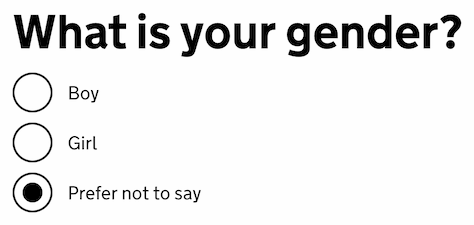Content warning
There are references to Gender, Transphobia and the NHS in this post.
Disclaimer
I write this post based on research I've done and people I've talked to.
If you see something wrong (or even a bit off), please do reach out to me and I'll be happy to improve it.
We should be making products that support trans/non-binary people. This post is focussed on young trans/non-binary people but will hopefully help you to build inclusive products for any ages.
Where are we currently?
An issue with many products I see is they can exclude young people of different genders.
If you’re not aware, as well as being a boy or girl, other genders such as non-binary exist. Many more genders exist than those but we'll focus on non-binary in this post.
I reached out to to Arora who runs Non-Binary in Tech, she shared this with me:
A survey conducted by Glaad and Harris Poll found that 12% of millenials identify outside of the gender binary. That’s about 1 out of every 8.
This is growing more and more with young people. Just over 1 in 4 (27%) of California teens identify as gender-nonconforming according to a study by the Williams Institute at the University of California, Los Angeles.
How does this effect products and young peoples' experiences?
In a product there could be a gender form that asks:

If a non-binary/questioning child was to use this form it could be quite distressing. Not being represented can make them feel that it isn’t valid to be who they are.
Ideally it's recommended to not ask for gender at all. Apart from services like the NHS it's often not relevant.
But if you were to have to implement something on gender, you could have a free text box that let's you enter your gender as you want to. There is more work in the backend to clean and categorise data but it means people aren't limited to fixed choices.

Won't this cost money to do?
If you have time, read through this article from TIME on how Mattel (creator of Barbie) are creating a gender-neutral doll.
It focuses on young people, specifically Generation Alpha. This is young people born after 2010.
They are creating a gender-neutral doll for them. Making their products more inclusive is not new to them.
Most recently, in 2016, Mattel added three new body types to the Barbie doll: tall, petite and, most radically, curvy. It was the first time the company had made a major change to one of the most recognizable brands—and bodies—in the world in the doll’s almost-60-year history.
The change helped propel Barbie from a retrograde doll lambasted by feminists for her impossible shape to a modern toy. She is now on the rise. Her sales have been up for the past eight quarters, and she saw a 14% sales bump in the past year alone, according to Mattel.
By making their product lines more inclusive they are making a lot of money.
Separately, I think it is quite telling that (even with a conservative approach politically from their leadership) they see this as a good thing for their products to represent.
Why is this important?
With more and more hate in our society and media around trans people. It's important that we make sure our products are inclusive.
They should uplift and support trans and non-binary people.
Consult (pay) trans/non-binary people. Test with trans and non-binary people. Listen to trans and non-binary people.
Thanks to Arora, James, Debs, Louise, James, Nick and Finbar for proof reading and improving the original draft of this.